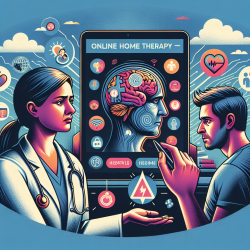Remote Assessment of Schizophrenia: Embracing Digital Tools for Better Outcomes
In the ever-evolving landscape of mental health care, the remote assessment of negative symptoms in schizophrenia has emerged as a promising frontier. As practitioners, understanding and implementing the latest research in this area can significantly enhance our ability to provide effective interventions. The research article "Remote Assessment of Negative Symptoms of Schizophrenia" provides valuable insights into how digital tools can be leveraged to assess and monitor these symptoms more effectively.
Understanding Negative Symptoms
Negative symptoms in schizophrenia, such as social withdrawal, reduced emotional expression, and lack of motivation, are crucial targets for intervention. Traditional face-to-face assessments have been the norm, but the advent of digital tools offers new opportunities for remote monitoring. The research highlights three primary modalities for remote assessment:
- Remote Administration of Existing Scales: Clinicians can use videoconferencing to administer established scales like the NSA-16 and BNSS in real-time.
- Direct Inference via Technology: Analyzing a patient's voice, appearance, or activity through smartphones or other devices can provide insights into negative symptoms.
- Ecological Momentary Assessment (EMA): Patients self-report their condition through periodic prompts from a smartphone, offering real-time data.
Advantages and Challenges
Remote assessment tools offer several advantages, including increased convenience, cost-effectiveness, and the ability to gather data in real-world settings. However, each modality comes with its own set of challenges. For instance, video assessments may not capture the nuances of negative symptoms as effectively as in-person interactions. Additionally, technological competence is required from both patients and practitioners, which can be a barrier for some.
Implementing Remote Assessment in Practice
For practitioners looking to integrate these tools into their practice, a multi-faceted approach may be most effective. Combining different modalities can provide a comprehensive view of a patient's symptoms. For example, using EMA to capture subjective experiences while employing computerized facial analysis for objective data can offer a well-rounded assessment.
It's also essential to consider the validation and standardization of these tools. Comparing remote assessments with in-person evaluations can help ensure their reliability and accuracy. Moreover, ongoing training and adaptation to new technologies will be crucial as the field continues to evolve.
Encouraging Further Research
While significant progress has been made, there is still much to learn about the remote assessment of negative symptoms. Practitioners are encouraged to stay informed about the latest research and consider participating in studies to contribute to the growing body of knowledge. By doing so, we can collectively work towards more effective and accessible mental health care for individuals with schizophrenia.
To read the original research paper, please follow this link: Remote Assessment of Negative Symptoms of Schizophrenia.










